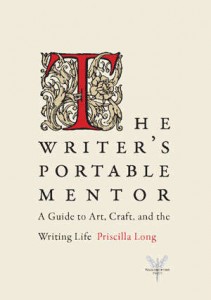 Advice for the Experienced Writer
Advice for the Experienced Writer
Long, Priscilla (2010). The Writer’s Portable Mentor: A Guide to Art, Craft, and the Writing Life. Seattle, WA: Wallingford Press, 349 pp.
My shelves are heavy with how-to-write books, some helpful, some inspirational, most inert. Priscilla Long’s book is different because it gets down to the nuts and bolts of writing, the brass tacks, the irreducible, atomic elements of the craft. You can read books all day on how to write scenes, develop character, and manage pacing, and those books are essential for beginners, but where writers often get bogged down is in neglect of, or ignorance of, the basics.
What are these basics? Chapter 2 is about using words better. It covers topics like Where to Find Good Words, collecting words, creating your own lexicon, sound effects, verb work. The exercises at the end of the chapter, like those in every chapter, are original, useful, and genuinely productive. For example, Take a page of a piece you’ve written. Circle all the verbs. Question each one. Change at least one. The result can be revelatory.
The chapter on observation is likewise an eye-opener, if only because it reminds the writer to rely on observation rather than abstraction. What is anger on someone’s face? Anyone can come up with a set of words, probably involving flushed cheeks, dilated pupils, flared nostrils; the usual stuff. Long encourages us to actually observe the face of someone who is angry. You’ll probably see few of the cliché pseudo-observations listed above, and you’ll have an original, compelling description based on what you do see. The same is true for observing gestures, voices, and colors. Simple advice, but stunning when you take it.
The longish middle section on “Finding a Structure” was a stretch of molasses for me. Granted, every work needs a structure. You can’t (or shouldn’t) just write into the void, without direction or form. But I thought Long’s overly-detailed, lengthy examples belabored the obvious, were uninteresting, and not well-written. In most cases, her explication of what the example was intended to illustrate amounted to little more than restating excerpts from that example, which explicates nothing. So the center of the book is weak and saggy, in my view.
However, the pace picks up strongly again toward the end with excellent chapters on grammar and punctuation; and these are not just lists of rules, but reminders of the possibilities. Many of us, without thinking about it, write in whatever syntax we’re familiar with. A wider syntactical scope can seriously enliven the writing.
There’s a tantalizing short chapter on metaphor and simile. It reviews basic definitions and provides examples, but it is tantalizing because it offers little analysis or advice. Aristotle said use of metaphor could not be taught, and maybe he was right. Long provides no exercises for this chapter.
The chapter on revision reframes what that task is. Instead of dreading the process, I now look forward to it with excitement. The chapter is a kind of summary of much of the previous material. The problem with revision is usually that you don’t know what to do about it. Sure, you can always find errors and improve your verb choices, but with Long’s checklist, you can visualize ramping the piece up to a whole new level of quality.
The final section, on how to get your work critiqued and ultimately published seems addressed to a beginning writer rather to the more experienced audience presumed so far. I can’t imagine anyone who has been writing for a while who doesn’t realize that you need to have readers who will give you feedback, and that you need to send your work out if you want to get it published. It’s a short, harmless chapter, but not a strong ending to an otherwise earth-moving book.
